Mesopotamia › Assyria » Ancient origins
Articles and Definitions › Contents
- Mesopotamia › Antique Origins
- Assyria › Antique Origins
Ancient civilizations › Historical and archaeological sites
Mesopotamia › Antique Origins
Definition and Origins

Mesopotamia (from the Greek, meaning 'between two rivers') was an ancient region located in the eastern Mediterranean bounded in the northeast by the Zagros Mountains and in the southeast by the Arabian Plateau, corresponding to today's Iraq, mostly, but also parts of modern-day Iran, Syria and Turkey. The 'two rivers' of the name referred to the Tigris and the Euphrates rivers and the land was known as 'Al-Jazirah' (the island) by the Arabs referencing what Egyptologist JH Breasted would later call the Fertile Crescent, where Mesopotamian civilization began.
THE CRADLE OF CIVILIZATION
Unlike the more unified civilizations of Egypt or Greece, Mesopotamia was a collection of varied cultures whose only real bonds were their script, their gods, and their attitude toward women. The social customs, laws, and even language of Akkad, for example, cannot be assumed to correspond to those of Babylon ; it does seem, however, that the rights of women, the importance of literacy, and the pantheon of the gods were indeed shared throughout the region (though the gods had different names in various regions and periods). As a result of this, Mesopotamia should be more properly understood as a region that produced multiple empires and civilizations rather than any single civilization. Even so, Mesopotamia is known as the “cradle of civilization” primarily because of two developments that occurred there, in the region of Sumer, in the 4th millenium BCE:
- the rise of the city as we recognize that entity today.
- the invention of writing (although writing is also known to have developed in Egypt, in the Indus Valley, in China, and to have taken form independently in Mesoamerica).
The invention of the wheel is also credited to the Mesopotamians and, in 1922 CE, the archaeologist Sir Leonard Woolley discovered “the remains of two four-wheeled wagons, [at the site of the ancient city of Ur ] the oldest wheeled vehicles in history ever found, along with their leather tires” (Bertman, 35). Other important developments or inventions credited to the Mesopotamians include, but are by no means limited to, domestication of animals, agriculture, common tools, sophisticated weaponry and warfare, the chariot, wine, beer, demarcation of time into hours, minutes, and seconds, religious rites, the sail (sailboats), and irrigation. Orientalist Samuel Noah Kramer, in fact, has listed 39 `firsts' in human civilization that originated in Sumer. These include:
The First Schools, The First Case of `Apple Polishing', The First Case of Juvenile Delinquency, The First ` War of Nerves', The First Bicameral Congress, The First Historian, The First Case of Tax Reduction, The First ` Moses ', The First Legal Precedent, The First Pharmacopoeia, The First `Farmer's Almanac', The First Experiment in Shade-Tree Gardening, Man's First Cosmogony and Cosmology, The First Moral Ideals, The First `Job', The First Proverbs and Sayings, The First Animal Fables, The First Literary Debates, The First Biblical Parallels, The First `Noah', The First Tale of Resurrection, The First `St. George', The First Case of Literary Borrowing, Man's First Heroic Age, The First Love Song, The First Library Catalogue, Man's First Golden Age, The First `Sick' Society, The First Liturgic Laments, The First Messiahs, The First Long-Distance Champion, The First Literary Imagery, The First Sex Symbolism, The First Mater Dolorosa, The First Lullaby, The First Literary Portrait, The First Elegies, Labor's First Victory, The First Aquarium.

Lion of Babylon
Archaeological excavations starting in the 1840s CE have revealed human settlements dating to 10,000 BCE in Mesopotamia that indicate that the fertile conditions of the land between two rivers allowed an ancient hunter-gatherer people to settle in the land, domesticate animals, and turn their attention to agriculture. Trade soon followed, and with prosperity came urbanizationand the birth of the city. It is generally thought that writing was invented due to trade, out of the necessity for long-distance communication, and for keeping more careful track of accounts.
THERE WERE OVER 1,000 DEITIES IN THE PANTHEON OF THE GODS OF THE MESOPOTAMIAN CULTURES.
LEARNING & RELIGION
Mesopotamia was known in antiquity as a seat of learning, and it is believed that Thales of Miletus (c. 585 BCE, known as the 'first philosopher') studied there. As the Babylonians believed that water was the 'first principle' from which all else flowed, and as Thales is famous for that very claim, it seems probable he studied in the region.
Intellectual pursuits were highly valued across Mesopotamia, and the schools (devoted primarily to the priestly class) were said to be as numerous as temples and taught reading, writing, religion, law, medicine, and astrology. There were over 1,000 deities in the pantheon of the gods of the Mesopotamian cultures and many stories concerning the gods (among them, the creation myth, the Enuma Elish). It is generally accepted that biblical tales such as the Fall of Man and the Flood of Noah (among many others) originated in Mesopotamian lore, as they first appear in Mesopotamian works such as The Myth of Adapa and the Epic of Gilgamesh, the oldest written story in the world. The Mesopotamians believed that they were co-workers with the gods and that the land was infused with spirits and demons (though `demons' should not be understood in the modern, Christian, sense).
The beginning of the world, they believed, was a victory by the gods over the forces of chaos but, even though the gods had won, this did not mean chaos could not come again. Through daily rituals, attention to the deities, proper funeral practices, and simple civic duty, the people of Mesopotamia felt they helped maintain balance in the world and kept the forces of chaos and destruction at bay. Along with expectations that one would honor one's elders and treat people with respect, the citizens of the land were also to honor the gods through the jobs they performed every day.
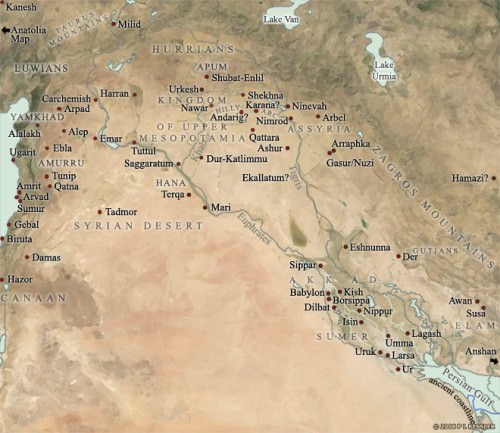
Map of Mesopotamia, 2000-1600 BC
JOBS
Men and women both worked, and “because ancient Mesopotamia was fundamentally an agrarian society, the principal occupations were growing crops and raising livestock” (Bertman, 274). Other occupations included those of the scribe, the healer, artisan, weaver, potter, shoemaker, fisherman, teacher, and priest or priestess. Bertman writes:
At the head of society were the kings and priests served by the populous staff of palace and temple. With the institution of standing armies and the spread of imperialism, military officers and professional soldiers took their place in Mesopotamia's expanding and diverse workforce. (274)
Women enjoyed nearly equal rights and could own land, file for divorce, own their own businesses, and make contracts in trade. The early brewers of beer and wine, as well as the healers in the community, were initially women. These trades were later taken over by men, it seems, when it became apparent they were lucrative occupations. The work one did, however, was never considered simply a `job' but one's contribution to the community and, by extension, to the gods' efforts in keeping the world at peace and in harmony.
BUILDINGS & GOVERNMENT
The temple, at the center of every city (often on a raised platform), symbolized the importance of the city's patron deity who would also be worshipped by whatever communities that city presided over. Mesopotamia gave birth to the world's first citieswhich were largely built of sun-dried brick. In the words of Bertman:
The domestic architecture of Mesopotamia grew out of the soil upon which it stood. Unlike Egypt, Mesopotamia –especially in the south– was barren of stone that could be quarried for construction.” The land was equally devoid of trees for timber, so the people “turned to other natural resources that lay abundantly at hand: the muddy clay of its riverbanks and the rushes and reeds that grew in their marshes. With them, the Mesopotamians created the world's first columns, arches, and roofed structures. (285)
Simple homes were constructed from bundles of reeds lashed together and inserted in the ground, while more complex homes were built of sun-dried clay brick (a practice followed later by the Egyptians). Cities and temple complexes, with their famous ziggurats (the step- pyramid structures indigenous to the region), were all built using oven-baked bricks of clay which were then painted.
PRIOR TO THE CONCEPT OF A KING, THE PRIESTLY RULERS ARE BELIEVED TO HAVE DICTATED THE LAW ACCORDING TO RELIGIOUS PRECEPTS.
The gods were thought to be present in the planning and execution of any building project and very specific prayers, recited in a set order to the proper deity, were considered of utmost importance in the success of the project and the prosperity of the occupants of the home.
Whichever kingdom or empire held sway across Mesopotamia, in whatever historical period, the vital role of the gods in the lives of the people remained undiminished. This reverence for the divine characterized the lives of both the field worker and the king. The historian Helen Chapin Metz writes:
The precariousness of existence in southern Mesopotamia led to a highly developed sense of religion. Cult centers such as Eridu, dating back to 5000 BCE, served as important centers of pilgrimage and devotion even before the rise of Sumer. Many of the most important Mesopotamian cities emerged in areas surrounding the pre-Sumerian cult centers, thus reinforcing the close relationship between religion and government. (2)
The role of the king was established at some point after 3600 BCE and, unlike the priest-rulers who came before, the king dealt directly with the people and made his will clear through laws of his own devising. Prior to the concept of a king, the priestly rulers are believed to have dictated the law according to religious precepts and received divine messages through signs and omens; the king, while still honoring and placating the gods, was considered a powerful enough representative of those gods to be able to speak their will through his own dictates, using his own voice.

Shalmaneser III
This is most clearly seen in the famous laws of Hammurabi of Babylon (r. 1792-1750 BCE), but a ruler claiming direct contact with the gods was quite common throughout Mesopotamian history, most notably in the Akkadian king Naram-Sin (r. 2261-2224 BCE) who went so far as to proclaim himself a god incarnate. The king was responsible for the welfare of his people and a good king, who ruled in accordance with divine will, was recognized by the prosperity of the region he reigned over.
Still, even very efficient rulers, such as Sargon of Akkad (r. 2334-2279 BCE), had to deal with perpetual uprisings and revolts by factions, or whole regions, contesting his legitimacy. As Mesopotamia was so vast a region, with so many different cultures and ethnicities within its borders, a single ruler attempting to enforce the laws of a central government would invariably be met with resistance from some quarter.
THE HISTORY OF MESOPOTAMIA
The history of the region, and the development of the civilizations which flourished there, is most easily understood by dividing it into periods:
Pre- Pottery Neolithic Age
Also known as The Stone Age (c. 10,000 BCE though evidence suggests human habitation much earlier). There is archaeological confirmation of crude settlements and early signs of warfare between tribes, most likely over fertile land for crops and fields for grazing livestock. Animal husbandry was increasingly practiced during this time with a shift from a hunter-gatherer culture to an agrarian one. Even so, the historian Marc Van De Mieroop notes:
There was not a sudden change from hunting-gathering to farming, but rather a slow process during which people increased their reliance on resources they managed directly, but still supplemented their diets by hunting wild animals. Agriculture enabled an increase in continuous settlement by people (12).
As more settlements grew, architectural developments slowly became more sophisticated in the construction of permanent dwellings.
Pottery Neolithic Age (c. 7,000 BCE)
In this period there was a widespread use of tools and clay pots and a specific culture begins to emerge in the Fertile Crescent. Scholar Stephen Bertman writes, “during this era, the only advanced technology was literally 'cutting edge'” as stone tools and weapons became more sophisticated. Bertman further notes that “the Neolithic economy was primarily based on food production through farming and animal husbandry” (55) and was more settled, as opposed to the Stone Age in which communities were more mobile. Architectural advancements naturally followed in the wake of permanent settlements as did developments in the manufacture of ceramics and stone tools.

Reconstruction of the Ziggurat of Ur
Copper Age (5,900 – 3,200 BCE)
Also known as The Chalcolithic Period owing to the transition from stone tools and weapons to ones made of copper. The rise of cities began in this period, most notably in the region of Sumer in which thrived the cities of Eridu, Uruk, Ur, Kish, Nuzi, Lagash, Nippur, and Ngirsu, and in Elam with its city of Susa. The earliest city is often cited as Uruk, although Eridu and Ur have also been suggested. Van De Mieroop writes, “Mesopotamia was the most densely urbanized region in the ancient world” (as cited in Bertman, 201), and the cities which grew up along the Tigris and Euphrates rivers, as well as those founded further away, established systems of trade which resulted in great prosperity.
This period saw the invention of the wheel (c. 3500 BCE) and writing (c. 3000 BCE), both by the Sumerians, the establishment of kingships to replace priestly rule, and the first war in the world recorded between the kingdoms of Sumer and Elam (3,200 BCE) with Sumer as the victor. Increased prosperity in the region gave rise to ornate temples and statuary, sophisticated pottery and figurines, toys for children (including dolls for girls and wheeled carts for boys), and the use of personal seals (known as Cylinder Seals) to denote ownership of property and to stand for an individual's signature. Cylinder Seals would be comparable to one's modern-day identification card or driver's license and, in fact, the loss or theft of one's seal would have been as significant as modern-day identity theft or losing one's credit cards.
Early Bronze Age (3,000 – 2119 BCE)
During this period, bronze supplanted copper as the material from which tools and weapons were made. The rise of the city-state laid the foundation for economic and political stability which would eventually lead to the rise of the Akkadian Empire (2350 BCE) and the rapid growth of the cities of Akkad and Mari, two of the most prosperous urban centers of the time. The cultural stability necessary for the creation of art in the region resulted in more intricate designs in architecture and sculpture, as well as the following inventions or improvements:
a number of specific and momentous inventions: the plough and the wheel, the chariot and the sailboat, and the cylinder-seal, the single most distinctive art form of ancient Mesopotamia and a pervasive demonstration of the importance of property ownership and business in the country's daily life. (Bertman, 55-56)
The Akkadian Empire of Sargon was the first multi-national realm in the world and Sargon's daughter, Enheduanna (2285-2250 BCE), the first author of literary works known by name. The library at Mari contained over 20,000 cuneiform tablets (books) and the palace there was considered one of the finest in the region.
HAMMURABI, KING OF BABYLON (1792-1750 BCE), ROSE FROM RELATIVE OBSCURITY TO CONQUER THE REGION & REIGN FOR 43 YEARS.
Middle Bronze Age (2119-1700 BCE)
The expansion of the Assyrian Kingdoms ( Assur, Nimrud, Sharrukin, Dur, and Nineveh ) and the rise of the Babylonian Dynasty (centered in Babylon and Chaldea) created an atmosphere conducive to trade and, with it, increased warfare. The Guti Tribe, fierce nomads who succeeded in toppling the Akkadian Empire, dominated the politics of Mesopotamia until they were defeated by the allied forces of the kings of Sumer. Hammurabi, King of Babylon rose from relative obscurity to conquer the region and reign for 43 years. Among his many accomplishments was his famous code of laws, inscribed on the stele of the gods. Babylon became a leading centre at this time for intellectual pursuit and high accomplishment in arts and letters.This cultural centre was not to last, however, and was sacked and looted by the Hittites who were then succeeded by the Kassites.
Late Bronze Age (1700-1100 BCE)
The rise of the Kassite Dynasty (a tribe who came from the Zagros Mountains in the north and are thought to have originated in modern-day Iran) leads to a shift in power and an expansion of culture and learning after the Kassites conquered Babylon.The collapse of the Bronze Age followed the discovery of how to mine ore and make use of iron, a technology which the Kassites and, earlier, the Hittites made singular use of in warfare.
The period also saw the beginning of the decline of Babylonian culture due to the rise in power of the Kassites until they were defeated by the Elamites and driven out. After the Elamites gave way to the Aramaeans, the small Kingdom of Assyria began a series of successful campaigns, and the Assyrian Empire was firmly established and prospered under the rule of Tiglath-Pileser I (r. 1115-1076 BCE) and, after him, Ashurnasirpal II (r. 884-859 BCE) consolidated the empire further. Most Mesopotamian states were either destroyed or weakened following the Bronze Age Collapse around 1200 BCE, leading to a short "dark age".

Ashurnasirpal II Wall Relief
Iron Age (1000 – 500 BCE)
This age saw the rise and expansion of the Neo-Assyrian Empire under Tiglath-Pileser III (r. 745-727 BCE) and that Empire's meteoric rise to power and conquest under the rule of great Assyrian kings such as Sargon II (722-705 BCE), Sennacherib(705-681 BCE), Esarhaddon (681-669 BCE) and Ashurbanipal (c. 668-627 BCE, who conquered Babylonia, Syria, Israel, and Egypt). The Empire suffered a decline as rapid as its rise due to repeated attacks on central cities by Babylonians, Medes, and Scythians.
The tribes of the Hittites and the Mitanni consolidated their respective powers during this time which resulted in the rise of the Neo- Hittite and Neo-Babylonian Empires. King Nebuchadnezzar II of Babylon destroyed Jerusalem (588 BCE) during this period and forced the inhabitants of Israel into the “Babylonian Exile”. He was also responsible for extensive construction in Babylon, creating famous buildings such as the Ishtar Gate and the Great Ziggurat (the "Tower of Babel "). The fall of Babylon to Cyrus II of Persia in 539 BCE effectively ended Babylonian culture.
AFTER CYRUS II TOOK BABYLON, THE BULK OF MESOPOTAMIA BECAME PART OF THE PERSIAN EMPIRE & SAW A RAPID CULTURAL DECLINE.
Classical Antiquity (500 BCE – 7th century CE)
After Cyrus II (d. 530 BCE) took Babylon, the bulk of Mesopotamia became part of the Achaemenid Persian Empire, and this period saw a rapid cultural decline in the region, most notably in the loss of the knowledge of cuneiform script. The conquest of the Persians by Alexander the Great in 331 BCE brought Hellenization of the culture and religion but, even though Alexandertried to again make Babylon a city of consequence, its days of glory were now in the past. After his death, Alexander's general Seleucus took control of the region and founded the Seleucid Dynasty which ruled until 126 BCE when the land was conquered by the Parthians who were, in turn, dominated by the Sassanians (a people of Persian descent). Bertman writes, “Under Sassanian domination, Mesopotamia lay in ruins, its fields dried out or turned into a swampy morass, its once great cities made ghost towns” (58).
By the time of the conquest by the Roman Empire (116 CE), Mesopotamia was a largely Hellenized region, lacking in any unity, which had forgotten the old gods and the old ways. The Romans improved the infrastructure of their colonies significantly through their introduction of better roads and plumbing and brought Roman Law to the land. Even so, the region was constantly caught up in the wars various Roman emperors waged with other nations over control of the land.
The entire culture of the region once known as Mesopotamia was swept away in the final conquest of the area by Muslim Arabs in the 7th century CE which resulted in the unification of law, language, religion and culture under Islam. Bertman notes, “With the Islamic conquest of 651 CE the history of ancient Mesopotamia ends” (58). Today the great cities that once rose along the Tigris and Euphrates rivers are largely unexcavated mounds or broken bricks on arid plains, and the once fertile crescent has steadily dwindled to a wasteland due to human factors (such as overuse of the land through agricultural pursuits or urban development) and also due to climate change.
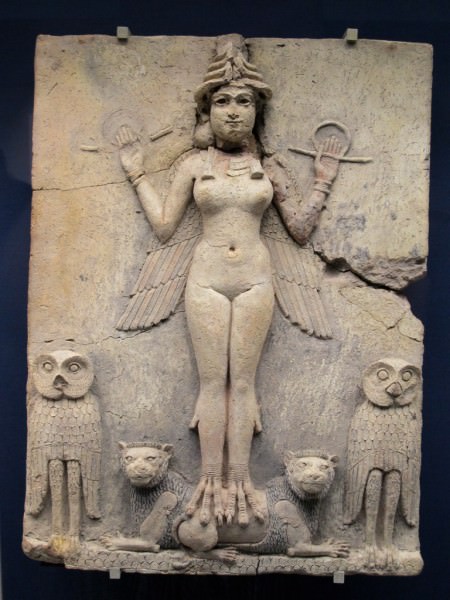
Queen of the Night
LEGACY
The legacy of Mesopotamia endures today through many of the most basic aspects of modern life such as the sixty-second minute and the sixty-minute hour. Helen Chapin Metz writes,
Because the well-being of the community depended upon close observation of natural phenomena, scientific or protoscientific activities occupied much of the priests' time. For example, the Sumerians believed that each of the gods was represented by a number. The number sixty, sacred to the god An, was their basic unit of calculation.The minutes of an hour and the notational degrees of a circle were Sumerian concepts. The highly developed agricultural system and the refined irrigation and water-control systems that enabled Sumer to achieve surplus production also led to the growth of large cities. (4)
Urbanization, the wheel, writing, astronomy, mathematics, wind power, irrigation, agricultural developments, animal husbandry, and the narratives which would eventually be re-written as the Hebrew Scriptures and provide the basis for the Christian Old Testament all came from the land of Mesopotamia.
As noted, Kramer lists 39 `firsts' from Mesopotamia in his book History Begins at Sumer and yet, as impressive as those `firsts' are, Mesopotamian contributions to world culture do not end with them. The Mesopotamians influenced the cultures of Egypt and Greece through long-distance trade and cultural diffusion and, through these cultures, impacted the culture of Romewhich set the standard for the development and spread of western civilization. Mesopotamia generally, and Sumer specifically, gave the world some of its most enduring cultural aspects and, even though the cities and great palaces are long gone, that legacy continued into the modern era.
In the 19th century CE, archaeologists of varying nationalities arrived in Mesopotamia to excavate for evidence which would corroborate the biblical tales of the Old Testament. At this time, the Bible was considered the oldest book in the world and the stories found in its pages were thought to be original compositions. The archaeologists who sought physical evidence to support the biblical stories found exactly the opposite once cuneiform was deciphered by the scholar and translator George Smith (1840-1876 CE) in 1872 CE. The story of the Great Flood and Noah's Ark, the story of the Fall of Man, the concept of a Garden of Eden, even the complaints of Job had all been written centuries before the biblical texts by the Mesopotamians.
Once cuneiform could be read, the ancient world of Mesopotamia opened up to the modern age and transformed people's understanding of the history of the world and themselves. The discovery of the Sumerian Civilization and the stories of the cuneiform tablets encouraged a new freedom of intellectual inquiry into all areas of knowledge. It was now understood that the biblical narratives were not original Hebrew works, the world was obviously older than the church had been claiming, there were civilizations which had risen and fallen long before that of Egypt and if these claims by authorities of church and schools had been false, perhaps others were as well.
The spirit of inquiry in the late 19th century was already making inroads into challenging the paradigms of accepted thought when Smith deciphered cuneiform but the discovery of Mesopotamian culture and religion encouraged this further. In ancient times, Mesopotamia impacted the world through its inventions, innovations, and religious vision; in the modern day it literally changed the way people understood the whole of history and one's place in the continuing story of human civilization.
Assyria › Antique Origins
Definition and Origins
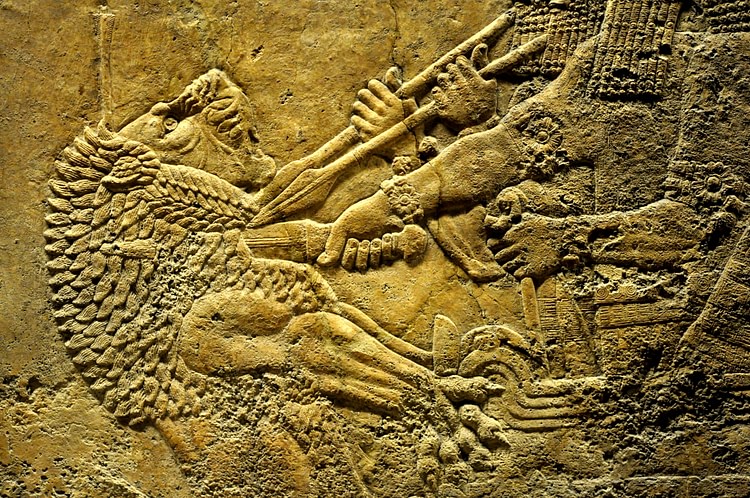
Assyria was the region located in the ancient Near East which, under the Neo-Assyrian Empire, reached from Mesopotamia (modern-day Iraq) through Asia Minor (modern Turkey ) and down through Egypt. The empire began modestly at the city of Ashur (known as Subartu to the Sumerians ), located in Mesopotamia north-east of Babylon, where merchants who traded in Anatolia became increasingly wealthy and that affluence allowed for the growth and prosperity of the city.
According to one interpretation of passages in the biblical Book of Genesis, Ashur was founded by a man named Ashur son of Shem, son of Noah, after the Great Flood, who then went on to found the other important Assyrian cities. A more likely account is that the city was named Ashur after the deity of that name sometime in the 3rd millennium BCE; the same god's name is the origin for `Assyria'. The biblical version of the origin of Ashur appears later in the historical record after the Assyrians had accepted Christianity and so it is thought to be a re-interpretation of their early history which was more in keeping with their newly-adopted belief system.
The Assyrians were a Semitic people who originally spoke and wrote Akkadian before the easier to use Aramaic language became more popular. Historians have divided the rise and fall of the Assyrian Empire into three periods: The Old Kingdom, The Middle Empire, and The Late Empire (also known as the Neo-Assyrian Empire), although it should be noted that Assyrian history continued on past that point; there are still Assyrians living in the regions of Iran and Iraq, and elsewhere, in the present day. The Assyrian Empire is considered the greatest of the Mesopotamian empires due to its expanse and the development of the bureaucracy and military strategies which allowed it to grow and flourish.
THE TRADE COLONY OF KARUM KANESH WAS AMONG THE MOST LUCRATIVE CENTRES FOR TRADE IN THE ANCIENT NEAR EAST.
THE OLD KINGDOM
Although the city of Ashur existed from the 3rd millennium BCE, the extant ruins of that city date to 1900 BCE which is now considered the date the city was founded. According to early inscriptions, the first king was Tudiya, and those who followed him were known as “kings who lived in tents” suggesting a pastoral, rather than urban, community.
Ashur was certainly an important centre of commerce even at this time, however, even though its precise form and structure is unclear. The king Erishum I built the temple of Ashur on the site in c. 1900/1905 BCE, and this has come to be the accepted date for the founding of an actual city on the site although, obviously, some form of city must have existed there prior to that date. The historian Wolfram von Soden writes,
Because of a dearth of sources, very little is known of Assyria in the third millennium…Assyria did belong to the Empire of Akkad at times, as well as to the Third Dynasty of Ur. Our main sources for this period are the many thousand Assyrian letters and documents from the trade colonies in Cappadocia, foremost of which was Kanesh (modern Kultepe). (49-50)

Map of Mesopotamia, 2000-1600 BC
The trade colony of Karum Kanesh (the Port of Kanesh) was among the most lucrative centres for trade in the ancient Near East and definitely the most important for the city of Ashur. Merchants from Ashur traveled to Kanesh, set up businesses, and then, after placing trusted employees (usually family members) in charge, returned to Ashur and supervised their business dealings from there. The historian Paul Kriwaczek notes:
For several generations the trading houses of Karum Kanesh flourished, and some became extremely wealthy – ancient millionaires. However not all business was kept within the family. Ashur had a sophisticated banking system and some of the capital that financed the Anatolian trade came from long-term investments made by independent speculators in return for a contractually specified proportion of the profits. There is not much about today's commodity markets that an old Assyrian would not quickly recognize. (214-215)
The Rise of Ashur
The wealth generated from trade in Karum Kanesh provided the people of Ashur with the stability and security necessary for the expansion of the city and so laid the foundation for the rise of the empire. Trade with Anatolia was equally important in providing the Assyrians with raw materials from which they were able to perfect the craft of iron working. The iron weapons of the Assyrian military would prove a decisive advantage in the campaigns which would conquer the entire region of the Near East. Before that could happen, however, the political landscape needed to change.
The people known as the Hurrians and the Hatti held dominance in the region of Anatolia and Ashur, to the north in Mesopotamia, remained in the shadow of these more powerful civilizations. In addition to the Hatti, there were the people known as the Amorites who were steadily settling in the area and acquiring more land and resources. The Assyrian king Shamashi Adad I (1813-1791 BCE) drove the Amorites out and secured the borders of Assyria, claiming Ashur as the capital of his kingdom. The Hatti continued to remain dominant in the region until they were invaded and assimilated by the Hittites in c. 1700.
Long before that time, however, they ceased to prove as major a concern as the city to the southwest which was slowly gaining power: Babylon. The Amorites were a growing power in Babylon for at least 100 years when the Amorite king named Sin Muballit took the throne, and, in c. 1792 BCE, his son King Hammurabi (1792-1750 BCE) ascended to rule and subjugated the lands of the Assyrians. It is around this same time that trade between Ashur and Karum Kanesh ended, as Babylon now rose to prominence in the region and took control of trade with Assyria.
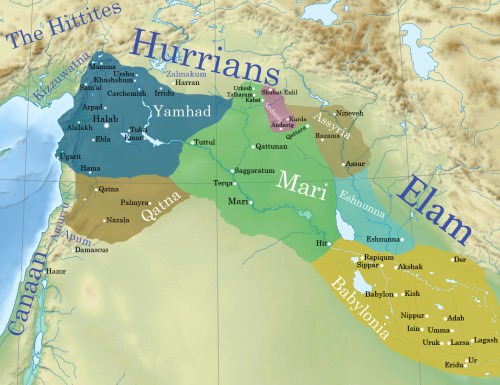
Ancient Syro-Mesopotamia ca. 1764 BCE
Soon after Hammurabi's death in 1750 BCE, the Babylonian Empire fell apart. Assyria again attempted to assert control over the region surrounding Ashur but it seems as though the kings of this period were not up to the task. Civil war broke out in the region, and stability was not regained until the reign of the Assyrian king Adasi (c. 1726-1691 BCE). Adasi was able to secure the region and his successors continued his policies but were unable or unwilling to engage in expansion of the kingdom.
THE MIDDLE EMPIRE
The vast Kingdom of Mitanni rose from the area of eastern Anatolia and now held power in the region of Mesopotamia;Assyria fell under their control. Invasions by the Hittites under King Suppiluliuma I (r.1344-1322 BCE) broke Mitanni power and replaced the kings of Mitanni with Hittite rulers at the same time that the Assyrian king Eriba Adad I was able to gain influence at the Mitanni (now mainly Hittite) court. The Assyrians now saw an opportunity to assert their own autonomy and began to expand their kingdom outward from Ashur to the regions previously held by the Mitanni.
The Hittites struck back and were able to hold the Assyrians at bay until the king Ashur-Uballit I (c.1353-1318 BCE) defeated the remaining Mitanni forces under the Hittite commanders and took significant portions of the region. He was succeeded by two kings who maintained what had been won, but no further expansion was achieved until the coming of King Adad Nirari I(c. 1307-1275 BCE) who expanded the Assyrian Empire to the north and south, driving out the Hittites and conquering their major strongholds.
ADAD NIRARI I IS THE FIRST ASSYRIAN KING ABOUT WHOM ANYTHING IS KNOWN WITH CERTAINTY.
Adad Nirari I is the first Assyrian king about whom anything is known with certainty because he left inscriptions of his achievements which have survived mostly intact. Further, letters between the Assyrian king and the Hittite rulers have also survived and make it clear that, initially, the Assyrian rulers were not taken seriously by those of other nations in the region until they proved themselves too powerful to resist. The historian Will Durant comments on the rise of the Assyrian Empire:
If we should admit the imperial principle – that it is good, for the sake of spreading law, security, commerce and peace, that many states should be brought, by persuasion or force, under the authority of one government – then we should have to concede to Assyria the distinction of having established in western Asia a larger measure and area of order and prosperity than that region of the earth had ever, to our knowledge, enjoyed before. (270)
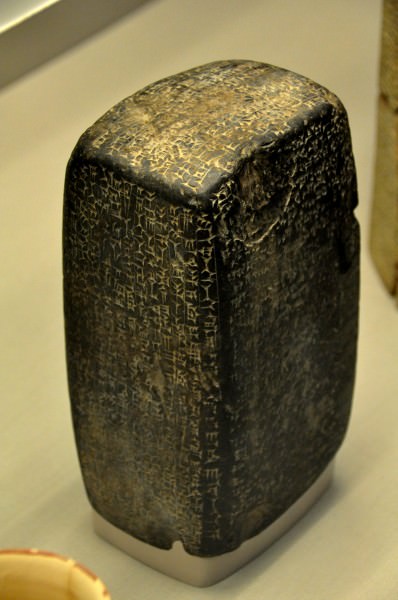 STONE FOUNDATION DOCUMENT OF KING ADAD-NIRARI I
STONE FOUNDATION DOCUMENT OF KING ADAD-NIRARI I

THE ASSYRIAN DEPORTATION POLICY
Adad Nirari I completely conquered the Mitanni and began what would become standard policy under the Assyrian Empire: the deportation of large segments of the population. With Mitanni under Assyrian control, Adad Nirari I decided the best way to prevent any future uprising was to remove the former occupants of the land and replace them with Assyrians. This should not be understood, however, as a cruel treatment of captives. Writing on this, the historian Karen Radner states,
The deportees, their labour and their abilities were extremely valuable to the Assyrian state, and their relocation was carefully planned and organised. We must not imagine treks of destitute fugitives who were easy prey for famine and disease: the deportees were meant to travel as comfortably and safely as possible in order to reach their destination in good physical shape. Whenever deportations are depicted in Assyrian imperial art, men, women and children are shown travelling in groups, often riding on vehicles or animals and never in bonds.There is no reason to doubt these depictions as Assyrian narrative art does not otherwise shy away from the graphic display of extreme violence. (1)
Deportees were carefully chosen for their abilities and sent to regions which could make the most of their talents. Not everyone in the conquered populace was chosen for deportation and families were never separated. Those segments of the population that had actively resisted the Assyrians were killed or sold into slavery, but the general populaces became absorbed into the growing empire and were thought of as Assyrians. The historian Gwendolyn Leick writes of Adad Nirari I that,
the prosperity and stability of his reign allowed him to engage in ambitious building projects, building city walls and canals and restoring temples. (3)
He also provided a foundation for empire upon which his successors would build.
ASSYRIAN CONQUEST OF MITANNI & THE HITTITES
His son and successor Shalmaneser I completed the destruction of the Mitanni and absorbed their culture. Shalmaneser I continued his father's policies, including the relocation of populations, but his son, Tukulti-Ninurta I (c. 1244-1208 BCE), went even further. According to Leick, Tukulti- Ninurta I,
...was one of the most famous Assyrian soldier kings who campaigned incessantly to maintain Assyrian possessions and influence. He reacted with spectacular cruelty to any sign of revolt. (177)
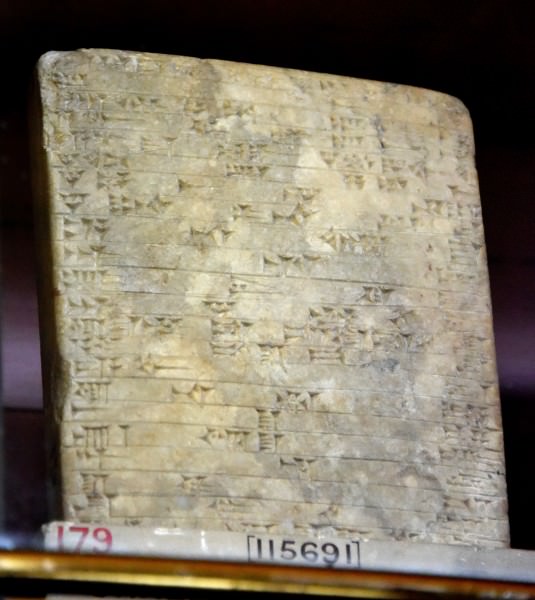
Stela of Shalmaneser I
He was also very interested in acquiring and preserving the knowledge and cultures of the peoples he conquered and developed a more sophisticated method of choosing which sort of individual, or community, would be relocated and to which specific location. Scribes and scholars, for example, were chosen carefully and sent to urban centers where they could help catalogue written works and help with the bureaucracy of the empire. A literate man, he composed the epic poem chronicling his victory over the Kassite king of Babylon and subjugation of that city and the areas under its influence and wrote another on his victory over the Elamites.
He defeated the Hittites at the Battle of Nihriya in c. 1245 BCE which effectively ended Hittite power in the region and began the decline of their civilization. When Babylon made incursions into Assyrian territory, Tukulti-Ninurta I punished the city severely by sacking it, plundering the sacred temples, and carrying the king and a portion of the populace back to Assur as slaves. With his plundered wealth, he renovated his grand palace in the city he had built across from Assur, which he named Kar-Tukulti-Ninurta, to which he seems to have retreated once the tide of popular opinion turned against him.
His desecration of the temples of Babylon was seen as an offense against the gods (as the Assyrians and Babylonians shared many of the same deities) and his sons and court officials rebelled against him for putting his hand on the goods of the gods.He was assassinated in his palace, probably by one of his sons, Ashur-Nadin-Apli, who then took the throne.
TIGLATH PILESER I & REVITALIZATION
Following the death of Tukulti-Ninurta I, the Assyrian Empire fell into a period of stasis in which it neither expanded nor declined. While the whole of the Near East fell into a 'dark age' following the so-called Bronze Age Collapse of c. 1200 BCE, Ashur and its empire remained relatively intact. Unlike other civilizations in the region which suffered a complete collapse, the Assyrians seem to have experienced something closer to simply a loss of forward momentum. The empire certainly cannot be said to have 'stagnated', because the culture, including the emphasis on military campaign and the value of conquest, continued; however, there was no significant expansion of the empire and civilization as it was under Tukulti-Ninurta I.
This all changed with the rise of Tiglath Pileser I to the throne (reigned c. 1115-1076 BCE). According to Leick:
He was one of the most important Assyrian kings of this period, largely because of his wide-ranging military campaigns, his enthusiasm for building projects, and his interest in cuneiform tablet collections. He campaigned widely in Anatolia, where he subjugated numerous peoples, and ventured as far as the Mediterranean Sea. In the capital city, Assur, he built a new palace and established a library, which held numerous tablets on all kinds of scholarly subjects. He also issued a legal decree, the so-called Middle Assyrian Laws, and wrote the first royal annals. He was also one of the first Assyrian kings to commission parks and gardens stocked with foreign and native trees and plants. (171)
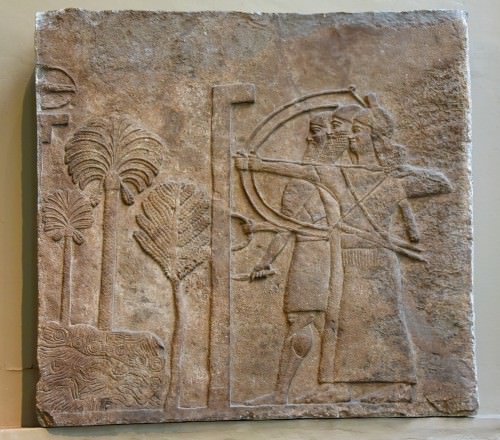
Babylonia under Assyrian Siege
Tiglath Pileser I revitalized the economy and the military through his campaigns, adding more resources and skilled populations to the Assyrian Empire. Literacy and the arts flourished, and the preservation initiative the king took regarding cuneiform tablets would serve as the model for the later ruler, Ashurbanipal ’s, famous library at Nineveh. Upon Tiglath Pileser I's death, his son, Asharid-apal-ekur, took the throne and reigned for two years during which time he continued his father's policies without alteration. He was succeeded by his brother Ashur-bel-Kala who initially reigned successfully until challenged by a usurper who threw the empire into civil war.
Although the rebellion was crushed and the participants executed, the turmoil allowed certain regions that had been tightly held by Assyria to break free and among these was the area known as Eber Nari (modern day Syria, Lebanon, and Israel ), which had been particularly important to the empire because of the well-established sea ports along the coast. The Aramaeans now held Eber Nari and began making incursions from there into the rest of the empire. At this same time, the Amorites of Babylon and the city of Mari asserted themselves and tried to break the hold of the empire.
The kings who followed Ashur-bel-Kala (among them, Shalmaneser II and Tiglath Pileser II) managed to maintain the core of the empire around Ashur but were unsuccessful in re-taking Eber Nari or driving the Aramaeans and Amorites completely from the borders. The empire steadily shrank through repeated attacks from outside and rebellions from within and, with no king strong enough to revitalize the military, Assyria again entered a period of stasis in which they held what they could of the empire together but could do nothing else.
THE NEO-ASSYRIAN EMPIRE
O Império Tardio (também conhecido como o Império Neo-Assírio) é o mais familiar para os estudantes da história antiga, pois é o período da maior expansão do império. It is also the era which most decisively gives the Assyrian Empire the reputation it has for ruthlessness and cruelty. The historian Kriwaczek writes:
A Assíria certamente deve estar entre os piores avisos de imprensa de qualquer estado da história. Babilônia pode ser um nome para corrupção, decadência e pecado, mas os assírios e seus governantes famosos, com nomes aterrorizantes como Salmanasar, Tiglate-Pileser, Senaqueribe, Assaradon e Assurbanipal, classificam a imaginação popular logo abaixo de Adolf Hitler e Gengis Khan por crueldade. violência e pura selvageria assassina. (208)
This reputation is further noted by the historian Simon Anglim and others. Anglim writes:
Enquanto os historiadores tendem a fugir das analogias, é tentador ver o Império Assírio, que dominou o Oriente Médio de 900 a 612 aC, como um antepassado histórico da Alemanha nazista: um regime agressivo, vingativo e vingativo apoiado por uma guerra magnífica e bem sucedida. máquina. As with the German army of World War II, the Assyrian army was the most technologically and doctrinally advanced of its day and was a model for others for generations afterwards. The Assyrians were the first to make extensive use of iron weaponry [and] not only were iron weapons superior to bronze, but could be mass-produced, allowing the equipping of very large armies indeed. (12)
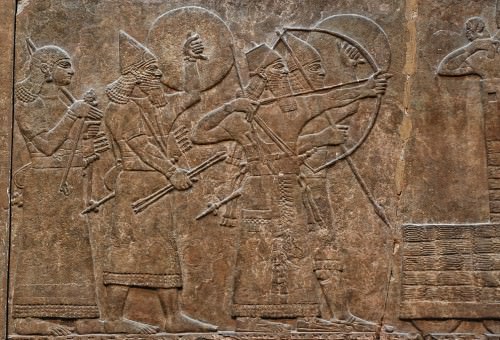
Assyrian Siege
While the reputation for decisive, ruthless, military tactics is understandable, the comparison with the Nazi regime is less so.Ao contrário dos nazistas, os assírios trataram os povos conquistados que eles se mudaram bem (como já foi abordado acima) e os consideraram assírios, uma vez que haviam se submetido à autoridade central. There was no concept of a 'master race' in Assyrian policies; everyone was considered an asset to the empire whether they were born Assyrian or were assimilated into the culture.Kriwaczek observa: “Na verdade, a guerra assíria não era mais selvagem que a de outros estados contemporâneos. Os assírios também não eram, de fato, mais cruéis que os romanos, que faziam questão de alinhar suas estradas com milhares de vítimas da crucificação morrendo em agonia ”(209). A única comparação justa entre a Alemanha na Segunda Guerra Mundial e os assírios, então, é a eficiência dos militares e o tamanho do exército, e essa mesma comparação pode ser feita com a Roma antiga.
A ASCENSÃO DO REI ADAD NIRARI II (C. 912-891 AEC) REPRODUZIU O TIPO DE AVIVERSÁRIO ASSÍGIO NECESSÁRIO.
These massive armies still lay in the future, however, when the first king of the Neo-Assyrian Empire came to power.A ascensão do rei Adad Nirari II (c. 912-891 aC) trouxe o tipo de reavivamento que a Assíria precisava. Adad Nirari II reconquistou as terras que haviam sido perdidas, incluindo Eber Nari, e assegurou as fronteiras.
Os aramaicos derrotados foram executados ou deportados para regiões do interior da Assíria. Ele também conquistou a Babilônia, mas, aprendendo com os erros do passado, recusou-se a saquear a cidade e, em vez disso, entrou em um acordo de paz com o rei no qual eles se casaram e prometeram lealdade mútua. Their treaty would secure Babylon as a powerful ally, instead of a perennial problem, for the next 80 years.
EXPANSÃO MILITAR E A NOVA VISÃO DE DEUS
The kings who followed Adad Nirari II continued the same policies and military expansion.Tukulti Ninurta II (891-884 aC) expandiu o império para o norte e ganhou mais território em direção ao sul, na Anatólia, enquanto Ashurnasirpal II (884-859 aC) consolidou o governo no Levante e ampliou o domínio assírio através de Canaã. Seu método mais comum de conquista era através da guerra de cerco que começaria com um ataque brutal à cidade. Anglim writes:
More than anything else, the Assyrian army excelled at siege warfare, and was probably the first force to carry a separate corps of engineers…Assault was their principal tactic against the heavily fortified cities of the Near East. They developed a great variety of methods for breaching enemy walls: sappers were employed to undermine walls or to light fires underneath wooden gates, and ramps were thrown up to allow men to go over the ramparts or to attempt a breach on the upper section of wall where it was the least thick. Mobile ladders allowed attackers to cross moats and quickly assault any point in defences. These operations were covered by masses of archers, who were the core of the infantry. But the pride of the Assyrian siege train were their engines.These were multistoried wooden towers with four wheels and a turret on top and one, or at times two, battering rams at the base. (186)
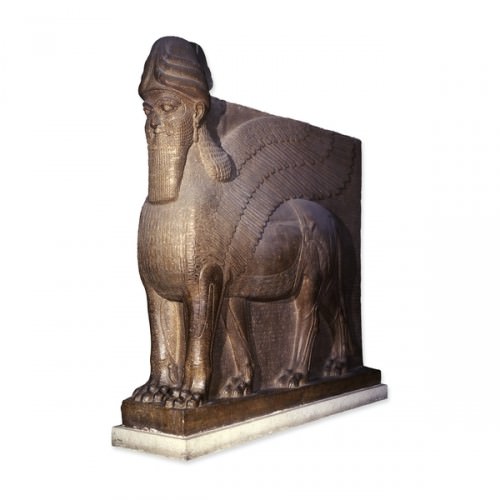
Estátua colossal de um leão alado do Palácio Noroeste de Ashurnasirpal II
Avanços na tecnologia militar não foram a única, ou mesmo a principal, contribuição dos assírios, pois, durante esse mesmo período, eles fizeram progressos significativos na medicina, construindo sobre a fundação dos sumérios e aproveitando o conhecimento e os talentos daqueles que tinham foram conquistados e assimilados. Ashurnasirpal II made the first systematic lists of plants and animals in the empire and brought scribes with him on campaign to record new finds. Schools were established throughout the empire but were only for the sons of the wealthy and nobility.
Women were not allowed to attend school or hold positions of authority even though, earlier in Mesopotamia, women had enjoyed almost equal rights. The decline in women's rights correlates to the rise of Assyrian monotheism. Enquanto os exércitos assírios faziam campanha por toda a terra, seu deus Ashur foi com eles, mas, como Ashur estava anteriormente ligado ao templo daquela cidade e só tinha sido adorado lá, uma nova maneira de imaginar o deus tornou-se necessária para continuar aquela adoração. em outras localidades. Kriwaczek writes:
One might pray to Ashur not only in his own temple in his own city, but anywhere. As the Assyrian empire expanded its borders, Ashur was encountered in even the most distant places. From faith in an omnipresent god to belief in a single god is not a long step. Since He was everywhere, people came to understand that, in some sense, local divinities were just different manifestations of the same Ashur. (231)
This unity of vision of a supreme deity helped to further unify the regions of the empire. Os diferentes deuses dos povos conquistados, e suas várias práticas religiosas, foram absorvidos na adoração de Ashur, que foi reconhecido como o único deus verdadeiro que tinha sido chamado de diferentes nomes por pessoas diferentes no passado, mas que agora era claramente conhecido e podia ser corretamente adorado como a divindade universal. Regarding this, Kriwaczek writes:
Belief in the transcendence rather than immanence of the divine had important consequences. Nature came to be desacralized, deconsecrated. Since the gods were outside and above nature, humanity – according to Mesopotamian belief created in the likeness of the gods and as servant to the gods – must be outside and above nature too. Rather than an integral part of the natural earth, the human race was now her superior and her ruler.The new attitude was later summed up in Genesis 1:26: `And God said, Let us make man in our image, after our likeness: and let him have dominion over the fish of the sea, and over the fowl of the air, and over the cattle, and over all the earth, and over every creeping thing that creepeth upon the earth' That is all very well for men, explicitly singled out in that passage. But for women it poses an insurmountable difficulty. While males can delude themselves and each other that they are outside, above, and superior to nature, women cannot so distance themselves, for their physiology makes them clearly and obviously part of the natural world…It is no accident that even today those religions that put most emphasis on God's utter transcendence and the impossibility even to imagine His reality should relegate women to a lower rung of existence, their participation in public religious worship only grudgingly permitted, if at all. (229-230)
The Assyrian culture became increasingly cohesive with the expansion of the empire, the new understanding of the deity, and the assimilation of the people from the conquered regions. Shalmaneser III (859-824 BCE) expanded the empire up through the coast of the Mediterranean and received tribute from the wealthy Phoenician cities of Tyre and Sidon.Ele também derrotou o reino armênio de Urartu, que há muito provou ser um incômodo significativo para os assírios. Following his reign, however, the empire erupted in civil war as the king Shamshi Adad V (824-811 BCE) fought with his brother for control.Although the rebellion was put down, expansion of the empire halted after Shalmaneser III.
The regent Shammuramat (also famously known as Semiramis who became the mythical goddess-queen of the Assyrians in later tradition) held the throne for her young son Adad Nirari III from c. 811-806 BCE and, in that time, secured the borders of the empire and organized successful campaigns to put down the Medes and other troublesome populaces in the north.
When her son came of age, she was able to hand him a stable and sizeable empire which Adad Nirari III then expanded further. Following his reign, however, his successors preferred to rest on the accomplishments of others and the empire entered another period of stagnation. This was especially detrimental to the military which languished under kings like Ashur Dan III and Ashur Nirari V.
TIGLATH PILESER III (745-727 BCE) REORGANIZED THE MILITARY & RESTRUCTURED THE BUREAUCRACY OF THE GOVERNMENT.
THE GREAT KINGS OF THE NEO-ASSYRIAN EMPIRE
The empire was revitalized by Tiglath Pileser III (745-727 BCE) who reorganized the military and restructured the bureaucracy of the government. According to Anglim, Tiglath Pileser III “carried out extensive reforms of the army, reasserted central control over the empire, reconquered the Mediterranean seaboard, and even subjugated Babylon. He replaced conscription [in the military] with a manpower levy imposed on each province and also demanded contingents from vassal states” (14). He defeated the kingdom of Uratu, which had again risen to trouble Assyrian rulers, and subjugated the region of Syria. Under Tiglath Pileser III's reign, the Assyrian army became the most effective military force in history up until that time and would provide a model for future armies in organization, tactics, training, and efficiency.
Tiglath Pileser III was followed by Shalmaneser V (727-722 BCE) who continued the king's policies, and his successor, Sargon II (722-705 BCE) improved upon them and expanded the empire further. Even though Sargon II's rule was contested by nobles, who claimed he had seized the throne illegally, he maintained the cohesion of the empire. Following Tiglath Pileser III's lead, Sargon II was able to bring the empire to its greatest height and decisively defeated Urartu in his famous campaign of 714 BCE.
After his death, he was succeeded by his son Sennacherib (705-681 BCE) who campaigned widely and ruthlessly, conquering Israel, Judah, and the Greek provinces in Anatolia. His sack of Jerusalem is detailed on the 'Taylor Prism', a cuneiform block describing Sennacherib's military exploits which was discovered in 1830 CE by Britain ’s Colonel Taylor, in which the king claims to have captured 46 cities and trapped the people of Jerusalem inside the city until he overwhelmed them. His account is contested, however, by the version of events described in the biblical book of II Kings, chapters 18-19, where it is claimed that Jerusalem was saved by divine intervention and Sennacherib's army was driven from the field. The biblical account does relate the Assyrian conquest of the region, however.
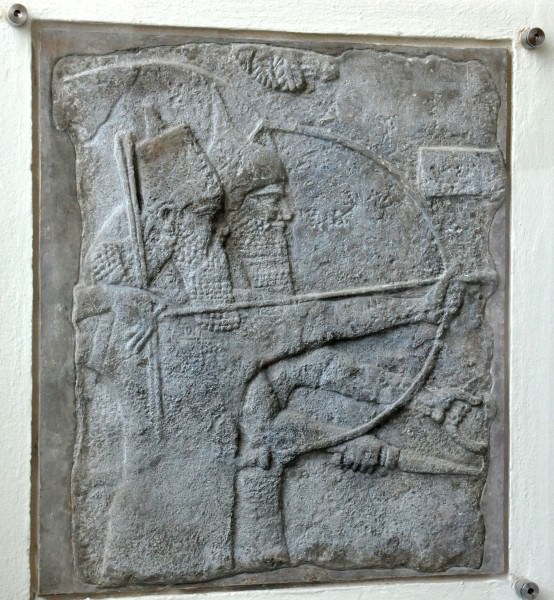
King Tiglath-pileser III holds a bow
Sennacherib's military victories increased the wealth of the empire. He moved the capital to Nineveh and built what was known as “the Palace without a Rival”. He beautified and improved upon the city's original structure, planting orchards and gardens.The historian Christopher Scarre writes,
Sennacherib's palace had all the usual accoutrements of a major Assyrian residence: colossal guardian figures and impressively carved stone reliefs (over 2,000 sculptured slabs in 71 rooms). Its gardens, too, were exceptional. Recent research by British Assyriologist Stephanie Dalley has suggested that these were the famous Hanging Gardens, one of the Seven Wonders of the Ancient World. Later writers placed the Hanging Gardens at Babylon, but extensive research has failed to find any trace of them. Sennacherib's proud account of the palace gardens he created at Nineveh fits that of the Hanging Gardens in several significant details (231).
Ignoring the lessons of the past, however, and not content with his great wealth and the luxury of the city, Sennacherib drove his army against Babylon, sacked it, and looted the temples. As earlier in history, the looting and destruction of the temples of Babylon was seen as the height of sacrilege by the people of the region and also by Sennacherib's sons who assassinated him in his palace at Nineveh in order to placate the wrath of the gods. Although they certainly would have been motivated to murder their father for the throne (after he chose his youngest son, Esarhaddon, as heir in 683 BCE, snubbing them) they would have needed a legitimate reason to do so; and the destruction of Babylon provided them with one.
ESARHADDON (681-669 BCE) SUCCESSFULLY CONQUERED EGYPT & ESTABLISHED THE EMPIRE'S BORDERS AS FAR NORTH AS THE ZAGROS MOUNTAINS.
His son Esarhaddon (681-669 BCE) took the throne, and one of his first projects was to rebuild Babylon. He issued an official proclamation which claimed that Babylon had been destroyed by the will of the gods owing to the city's wickedness and lack of respect for the divine.
Nowhere in his proclamation does it mention Sennacherib or his role in the destruction of the city but makes clear that the gods chose Esarhaddon as the divine means for restoration: “Once during a previous ruler's reign there were bad omens. The city insulted its gods and was destroyed at their command. They chose me, Esarhaddon, to restore everything to its rightful place, to calm their anger, and soothe their rage.”
The empire flourished under his reign. He successfully conquered Egypt (which Sennacherib had tried and failed to do) and established the empire's borders as far north as the Zagros Mountains (modern day Iran) and as far south as Nubia (modern Sudan) with a span from west to east of the Levant (modern day Lebanon to Israel) through Anatolia (Turkey). His successful campaigns, and careful maintenance of the government, provided the stability for advances in medicine, literacy, mathematics, astronomy, architecture, and the arts. Durant writes:
In the field of art, Assyria equaled her preceptor Babylonia and in bas-relief surpassed her. Stimulated by the influx of wealth into Ashur, Kalakh, and Nineveh, artists and artisans began to produce – for nobles and their ladies, for kings and palaces, for priests and temples – jewels of every description, cast metal as skilfully designed and finely wrought as on the great gates at Balawat, and luxurious furniture of richly carved and costly woods strengthened with metal and inlaid with gold, silver, bronze, or precious stones. (278)
In order to secure the peace, Esarhaddon's mother, Zakutu (also known as Naqia-Zakutu) entered into vassal treaties with the Persians and the Medes requiring them to submit in advance to his successor. This treaty, known as the Loyalty Treaty of Naqia-Zakutu, ensured the easy transition of power when Esarhaddon died preparing to campaign against the Nubians and rule passed to the last great Assyrian king, Ashurbanipal (668-627 BCE). Ashurbanipal was the most literate of the Assyrian rulers and is probably best known in the modern day for the vast library he collected at his palace at Nineveh.
Though a great patron of the arts and culture, Ashurbanipal could be just as ruthless as his predecessors in securing the empire and intimidating his enemies. Kriwaczek writes,
Which other imperialist would, like Ashurbanipal, have commissioned a sculpture for his palace with decoration showing him and his wife banqueting in their garden, with the struck-off head and severed hand of the King of Elam dangling from trees on either side, like ghastly Christmas baubles or strange fruit? (208).
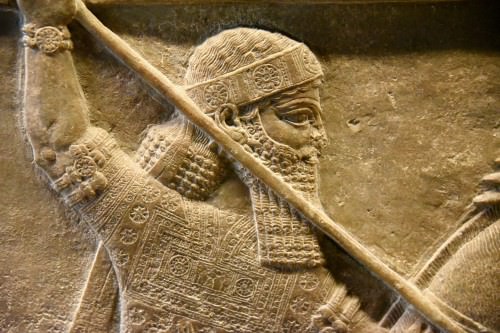
Ashurbanipal II
He decisively defeated the Elamites and expanded the empire further to the east and north. Recognizing the importance of preserving the past, he then sent envoys to every point in the lands under his control and had them retrieve or copy the books of that city or town, bringing all back to Nineveh for the royal library.
Ashurbanipal ruled over the empire for 42 years and, in that time, campaigned successfully and ruled efficiently. The empire had grown too large, however, and the regions were overtaxed. Further, the vastness of the Assyrian domain made it difficult to defend the borders. As great in number as the army remained, there were not enough men to keep garrisoned at every significant fort or outpost.
When Ashurbanipal died in 627 BCE, the empire began to fall apart. His successors Ashur-etli-Ilani and Sin-Shar-Ishkun were unable to hold the territories together and regions began to break away. The rule of the Assyrian Empire was seen as overly harsh by its subjects, in spite of whatever advancements and luxuries being an Assyrian citizen may have provided, and former vassal states rose in revolt.
IN 612 BCE NINEVEH WAS SACKED & BURNED BY A COALITION OF BABYLONIANS, PERSIANS, MEDES, & SCYTHIANS.
In 612 BCE Nineveh was sacked and burned by a coalition of Babylonians, Persians, Medes, and Scythians, among others.The destruction of the palace brought the flaming walls down on the library of Ashurbanipal and, although it was far from the intention, preserved the great library, and the history of the Assyrians, by baking hard and burying the clay tablet books.Kriwaczek writes, “Thus did Assyria's enemies ultimately fail to achieve their aim when they razed Ashur and Nineveh in 612 BCE, only fifteen years after Ashurbanipal's death: the wiping out of Assyria's place in history” (255). Still, the destruction of the great Assyrian cities was so complete that, within two generations of the empire's fall, no one knew where the cities had been. The ruins of Nineveh were covered by the sands and lay buried for the next 2,000 years.
LEGACY OF ASSYRIA
Thanks to the Greek historian Herodotus, who considered the whole of Mesopotamia 'Assyria', scholars have long known the culture existed (as compared to the Sumerians who were unknown to scholarship until the 19th century CE). Mesopotamian scholarship was traditionally known as Assyriology until relatively recently (though that term is certainly still in use), because the Assyrians were so well known through the primary sources of the Greek and Roman writers.
Through the expanse of their empire, the Assyrians spread Mesopotamian culture to the other regions of the world, which have, in turn, impacted cultures world-wide up to the present day. Durant writes:
Through Assyria's conquest of Babylon, her appropriation of the ancient city's culture, and her dissemination of that culture throughout her wide empire; through the long Captivity of the Jews, and the great influence upon them of Babylonian life and thought; through the Persian and Greek conquests which then opened with unprecedented fullness and freedom all the roads of communication and trade between Babylon and the rising cities of Ionia, Asia Minor, and Greece – through these and many other ways the civilization of the Land between the Rivers passed down into the cultural endowment of our race. In the end nothing is lost; for good or evil, every event has effects forever. (264)
Tiglath Pileser III had introduced Aramaic to replace Akkadian as the lingua franca of the empire and, as Aramaic survived as a written language, this allowed later scholars to decipher Akkadian writings and then Sumerian. The Assyrian conquest of Mesopotamia, and the expansion of the empire throughout the Near East, brought Aramaic to regions as near as Israel and as far as Greece and, in this way, Mesopotamian thought became infused with those cultures and a part of their literary and cultural heritage.
Following the decline and rupture of the Assyrian empire, Babylon assumed supremacy in the region from 605-549 BCE.Babylon then fell to the Persians under Cyrus the Great who founded the Achaemenid Empire (549-330 BCE) which fell to Alexander the Great and, after his death, was part of the Seleucid Empire.
The region of Mesopotamia corresponding to modern-day Iraq, Syria, and part of Turkey was the area at this time known as Assyria and, when the Seleucids were driven out by the Parthians, the western section of the region, formerly known as Eber Nari and then Aramea, retained the name Syria. The Parthians gained control of the region and held it until the coming of Rome in 116 CE, and then the Sassanid Empire held supremacy in the area from 226-650 CE until, with the rise of Islam and the Arabian conquests of the 7th century CE, Assyria ceased to exist as a national entity.
Among the greatest of their achievements, however, was the Aramaic alphabet, imported into the Assyrian government by Tiglath Pileser III from the conquered region of Syria. Aramaean was easier to write than Akkadian and so older documents collected by kings such as Ashurbanipal were translated from Akkadian into Aramaic, while newer ones were written in Aramaic and ignored the Akkadian. The result was that thousands of years of history and culture were preserved for future generations and this is the greatest of Assyria's legacies.
MAP
LICENSE:
Article based on information obtained from these sources:with permission from the Website Ancient History Encyclopedia
Content is available under License Creative Commons: Attribution-NonCommercial-ShareAlike 3.0 Unported. CC-BY-NC-SA License